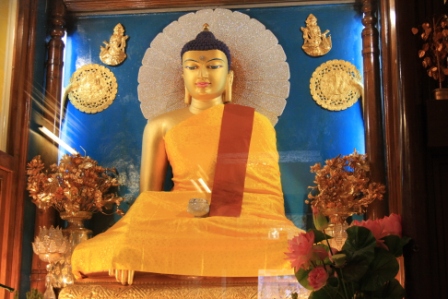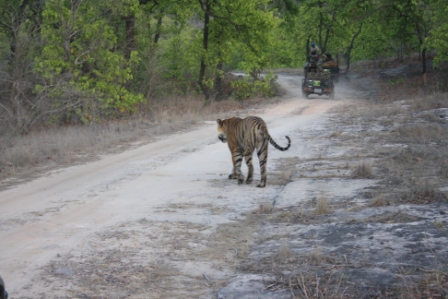Search This Blog
Friday, April 30, 2010
Sunday, April 25, 2010
Saturday, April 24, 2010
Friday, April 23, 2010
Day 7: The Handsome "Kalua" poses for us in Bandavgarh Forest
Bandhavgarh has one of the highest density of Bengal tigers known in the world, and is home to some famous named tigers which are large in size and are beautiful. Charger, an animal so named because of his habit of charging at elephants and tourists (whom he nonetheless did not harm), was the first healthy male known to be living in Bandhavgarh since the 1990s. A female known as Sita, who once appeared on the cover of National Geographic and is considered as the second most photographed tiger in the world, was also to be found in Bandhavgarh for many years. Almost all the tigers of Bandhavgarh today are descendants of Sita and Charger. Their daughter Mohini, son Langru and B2 also maintained their tradition for frequent sighting and moving close to tourist jeeps.
Mohini, became prominent following Sita's death. She mated with Mahaman Tiger. She later died of her wounds from a vehicle accident.
Charger died in 2000 and his body was buried at Charger Point where he was kept in a closed region at his old age. Between 2003 and 2006, many of his descendants met with a series of unfortunate ends. B1 was electrocuted and B3 was killed by poachers. Sita was killed by poachers. Mohini died of serious wounds to her body. After the death of Charger, the fully grown B2 survived as the dominant male in the forest between 2004 and 2007. He also became the strongest tiger in the world. Mating with a female in the Siddhababa region of Bandhavgarh, he became a father of three cubs. One of them was a male. He was named Bamera. He was first sighted in 2008 and is now Bandhavgarh's dominant male. In November 2011, B2 died. Postmortem studies suggest that he died a natural death. But many other professional people,[who?] who know more than the officials, say that he was injured by the villagers of the village in the buffer area.
Now, the most prominent tiger in Tala zone of Bandhavgarh National Park is Bamera (Died recently). However, of late[when?] he has been challenged on several occasions by a new male. Blue Eyes (Died recently due to drug over dose) and Mukunda are the dominant males of Magdhi and Khitauli zone respectively. The females who are seen more frequently are Rajbehra, Mirchaini, Banbehi, Mahaman, Sukhi Pattiya and Damdama. There are quite a few cubs also who are either in sub-adult stage or have entered adulthood and are separate now.
Labels:
Bandhavgarh National Park,
Birds,
Monuments,
Road Trips,
SWIFT ZXi,
Travel,
Wildlife
Thursday, April 22, 2010
Day 6: Two Jungle Safaris into the Bandavgarh Forest
With the tiger at the apex of the food chain, it contains 37 species of mammals. According to forest officials, there are more than 250 species of birds, about 80 species of butterflies, a number of reptiles. But many people have the species' list of about 350 birds along with photographs. The richness and tranquity of grasslands invites pairs of sarus cranes to breed in the rainy season.
One of the biggest attractions of this national park is the tiger (Panthera tigris tigris) and its sightings. Bandhavgarh has a very high density of tigers within the folds of its jungles. The 105 km2 of park area open to tourists was reported to have 22 tigers, a density of one tiger for every 4.77 km2. (Population estimation exercise 2001). The population of tigers in the park in 2012 is about 44-49. There is a saying about the Park that goes: "In any other Park, you are lucky if you see a tiger. In Bandhavgarh, you are unlucky if you don't see (at least) one."
Bandhavgarh tiger reserve is densely populated with other species: the gaur, or Indian bison, are now extinct or have migrated elsewhere; sambar and barking deer are a common sight, and nilgai are to be seen in the open areas of the park. There have been reports of the Indian wolf (canis lupus indica), striped hyena, and the caracal the latter being an open country dweller. The tiger reserve abounds with chital or the spotted deer (Axis axis) which is the main prey animal of the tiger and the Indian leopard (Panthera pardus fusca). The Indian bison were reintroduced from Kanha.
One of the biggest attractions of this national park is the tiger (Panthera tigris tigris) and its sightings. Bandhavgarh has a very high density of tigers within the folds of its jungles. The 105 km2 of park area open to tourists was reported to have 22 tigers, a density of one tiger for every 4.77 km2. (Population estimation exercise 2001). The population of tigers in the park in 2012 is about 44-49. There is a saying about the Park that goes: "In any other Park, you are lucky if you see a tiger. In Bandhavgarh, you are unlucky if you don't see (at least) one."
Bandhavgarh tiger reserve is densely populated with other species: the gaur, or Indian bison, are now extinct or have migrated elsewhere; sambar and barking deer are a common sight, and nilgai are to be seen in the open areas of the park. There have been reports of the Indian wolf (canis lupus indica), striped hyena, and the caracal the latter being an open country dweller. The tiger reserve abounds with chital or the spotted deer (Axis axis) which is the main prey animal of the tiger and the Indian leopard (Panthera pardus fusca). The Indian bison were reintroduced from Kanha.
Labels:
Bandhavgarh National Park,
Birds,
Road Trips,
SWIFT ZXi,
Travel,
Wildlife
Subscribe to:
Posts (Atom)
Most Popular Posts till date
-
I was invited for lunch with the in-laws and what better place than Mainland China at South City Mall. Add to that the fact that it was thei...
-
The Tollygunge Club put together a Vintage Car Show along with a Pet Show. This coming close on the heels of the Statesman Vintage & C...
-
Our last excursion to Eco Park in Rajarhat dates all the way back to February 2015. Since then, a myriad of transformations has swept throu...
-
So here we are once more at The Tollygunge Club on a cold winter morning to catch some rare beauties to warm our hearts. I try to catch the...



























































